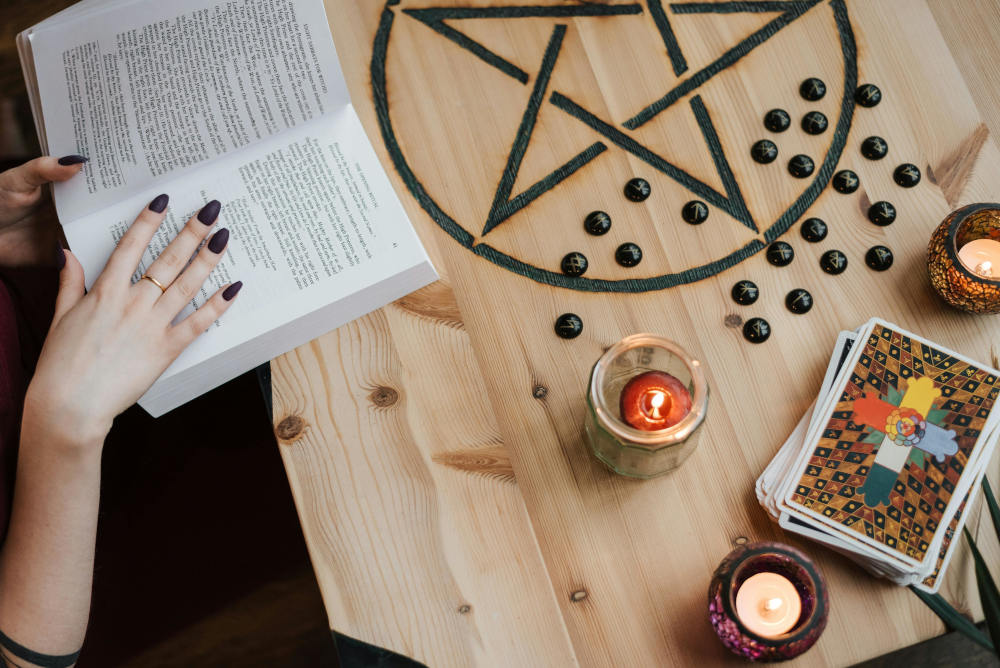
Alchemy often conjures images of secret laboratories, cryptic symbols, and medieval experiments to turn lead into gold. But real alchemy goes far deeper than physical transmutation—it’s a metaphor for personal transformation and a practical path for spiritual growth. While ancient alchemists used fire and flasks, modern seekers use awareness, intention, and disciplined practice to achieve inner “gold.”
So how can you actually do alchemy in real life? It’s not about science fiction or fantasy. It’s about applying ancient principles to your thoughts, emotions, habits, and energy to evolve into your highest self.
In this guide, we’ll explore the origins of alchemy, its symbolic language, and—most importantly—how you can apply alchemical practices in your everyday life.
Panaprium is independent and reader supported. If you buy something through our link, we may earn a commission. If you can, please support us on a monthly basis. It takes less than a minute to set up, and you will be making a big impact every single month. Thank you!
What Is Alchemy, Really?
Alchemy began as a proto-scientific and mystical tradition practiced in ancient Egypt, Greece, China, India, and the Islamic world. Its practical goal was to transform base metals like lead into gold, create an elixir of immortality, or discover the Philosopher’s Stone—a mysterious substance said to grant enlightenment and eternal life.
But underneath these material goals was a deeper purpose: spiritual transformation.
The real aim of alchemy was the perfection of the soul. By refining and purifying matter, the alchemist also purified their own spirit. The outer work mirrored the inner work.
Today, when we speak of alchemy in real life, we refer to this inner work: the process of turning your fears, doubts, and emotional “lead” into personal power, love, and wisdom.
The Core Principles of Alchemy
Real-life alchemy is based on a few timeless principles that guide transformation on every level—mental, emotional, spiritual, and even physical.
1. As Above, So Below
This famous Hermetic maxim means that everything in the universe is connected. The microcosm (you) reflects the macrocosm (the universe). Change your inner world, and your outer world changes too.
Real-Life Application: Practice inner alignment. When your thoughts, emotions, and actions are coherent, your life reflects that harmony.
2. Solve et Coagula
“Dissolve and coagulate” refers to breaking things down (solve) and then recombining them (coagula) into a higher form. This principle appears in everything from personal reinvention to spiritual awakening.
Real-Life Application: Let go of outdated beliefs, dissolve your ego, then rebuild your identity based on truth, love, and higher awareness.
3. Transmutation
Transmutation is at the heart of alchemy: the act of transforming something low or impure into something valuable and refined.
Real-Life Application: Use mindfulness to turn anger into assertiveness, fear into courage, and trauma into wisdom.
The 7 Stages of Alchemy: A Real-Life Journey
Alchemy is not just symbolic—it’s practical. The seven classical stages of alchemical transformation can be seen as steps in personal growth. You can apply these stages to heal relationships, overcome addiction, break toxic cycles, or pursue spiritual awakening.
Here’s how to practice each stage in your real life:
1. Calcination – Breaking Down the Ego
Calcination is the fiery process of burning away illusions and pride. In real life, this feels like hitting rock bottom—facing failure, betrayal, or loss that challenges your self-image.
Practice Tip: Confront your false self. Reflect on what you’ve been clinging to for identity (status, roles, masks). Practice humility and surrender.
2. Dissolution – Releasing Repressed Emotions
Dissolution means melting the hardened ego. Old emotional patterns, fears, and suppressed memories rise to the surface.
Practice Tip: Journal, meditate, or go to therapy. Let feelings come without judgment. Don’t numb them—observe them. This clears the psychic waters.
3. Separation – Discernment and Clarity
Now you begin sorting the true from the false. You analyze your values, beliefs, and desires with clarity. You learn to say “this is me” and “this is not.”
Practice Tip: Reflect on what really matters to you. Clean up your mental and physical environment. Let go of relationships and beliefs that no longer align.
4. Conjunction – Inner Union
This is where you integrate opposites: your head and heart, your masculine and feminine, your spiritual and earthly sides. You begin acting with balance and wisdom.
Practice Tip: Cultivate wholeness through creativity, sacred sexuality, deep meditation, or heart-based practices. Think integration, not perfection.
5. Fermentation – Awakening the Soul
Now something new begins to emerge. This is the birth of your higher self. You start seeing the world through fresh eyes, feeling more spiritually connected.
Practice Tip: Follow your inspiration. Pay attention to dreams, synchronicities, or intuitive nudges. Feed your soul with beauty, meaning, and service.
6. Distillation – Refining the Spirit
This stage requires discipline and purity. It’s about releasing the last bits of ego and aligning your actions with your inner truth.
Practice Tip: Commit to daily spiritual routines: meditation, clean eating, ethical living, sacred rituals. Purify your intentions and act with integrity.
7. Coagulation – Embodying Enlightenment
You become the Philosopher’s Stone: a person who has integrated body, mind, and soul. You are no longer seeking wholeness—you are living it.
Practice Tip: Serve others. Let your life be a reflection of your inner transformation. Teach, create, and live in alignment with your deepest truth.
Real-Life Alchemy Practices You Can Try Today
Alchemy can be applied not just to major life shifts but also to everyday actions. Here are practical tools you can use to “do alchemy” in your daily life:
1. Mindful Transmutation
When strong emotions arise—anger, jealousy, fear—pause and reflect. Ask yourself: “What is this teaching me? How can I turn this into growth?”
2. Dream Work
Dreams are the unconscious mind’s language, filled with alchemical symbols. Keep a dream journal. Look for patterns or recurring imagery and interpret them through an alchemical lens.
3. Inner Dialogue
Talk to different parts of yourself. Ask your shadow why it’s afraid. Invite your higher self to speak. This dialogue creates integration.
4. Nature Rituals
Go outside, light a fire, bury a symbol of something you're letting go of, or sit by running water. Use nature as your laboratory.
5. Creative Expression
Art, music, dance, and writing are tools of transformation. Alchemize your emotions through creation. Don’t just think—express.
6. Spiritual Study
Read Hermetic texts like The Emerald Tablet or modern guides like Carl Jung’s Psychology and Alchemy. Study spiritual systems that inspire you and help you deepen your understanding.
7. Sacred Space and Symbols
Create a space for inner work—your own alchemical “lab.” Use crystals, incense, candles, or meaningful symbols to remind you of your path.
Real-Life Example: Emotional Alchemy
Let’s say you’re struggling with resentment toward a friend who betrayed your trust. You can turn that emotional lead into gold through alchemical steps:
-
Calcination: Acknowledge your anger and pride.
-
Dissolution: Allow yourself to grieve and cry.
-
Separation: Discern what’s yours to own and what isn’t.
-
Conjunction: Find peace between your pain and your compassion.
-
Fermentation: Let forgiveness rise naturally.
-
Distillation: Choose new, clear boundaries moving forward.
-
Coagulation: Move forward with grace, stronger and wiser.
Is Alchemy Religious or Spiritual?
Alchemy has roots in many traditions—Egyptian, Taoist, Islamic, Christian, and more. But it’s not bound to any religion. You can approach it as a spiritual system, psychological model, or creative metaphor.
Many modern seekers blend alchemy with other paths like yoga, mindfulness, Gnosticism, or Jungian psychology. It’s flexible, symbolic, and deeply personal.
Final Thoughts: You Are the Gold
Alchemy isn’t just something you study—it’s something you live. Every moment is a chance to practice it. Every challenge is a crucible. Every choice is a tool for transformation.
To do alchemy in real life means to live consciously, courageously, and creatively. It means facing your shadow, refining your soul, and living from the gold that’s already inside you.
You don’t need a philosopher’s stone. You already are one—waiting to be revealed through fire, love, and awareness.
Recommended Resources:
-
The Emerald Tablet: Alchemy for Personal Transformation by Dennis William Hauck
-
Psychology and Alchemy by Carl Jung
-
The Kybalion by Three Initiates
-
Alchemy: Science of the Cosmos, Science of the Soul by Titus Burckhardt
-
Inner Alchemy by Mantak Chia (for Taoist perspective)
Was this article helpful to you? Please tell us what you liked or didn't like in the comments below.
About the Author: Alex Assoune
What We're Up Against
Multinational corporations overproducing cheap products in the poorest countries.
Huge factories with sweatshop-like conditions underpaying workers.
Media conglomerates promoting unethical, unsustainable products.
Bad actors encouraging overconsumption through oblivious behavior.
- - - -
Thankfully, we've got our supporters, including you.
Panaprium is funded by readers like you who want to join us in our mission to make the world entirely sustainable.
If you can, please support us on a monthly basis. It takes less than a minute to set up, and you will be making a big impact every single month. Thank you.































0 comments